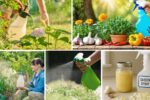If you’re dreaming of a garden bursting with bold, lively colors and attracting hummingbirds, bees, and butterflies, salvia plants are the perfect choice. Known for their stunning floral spikes and long blooming seasons, salvias come in a spectrum of brilliant hues—from fiery reds to serene blues and dazzling purples. These hardy, sun-loving plants are also easy to grow and drought-tolerant, making them garden favorites around the world.
Here’s a handpicked list of 12 salvia plants that can turn your garden into a vibrant, pollinator-friendly paradise.

1. Salvia splendens (Scarlet Sage)
Scarlet Sage is one of the most eye-catching salvias you can plant. Its bright, flame-red flower spikes bloom from late spring until the first frost, standing out brilliantly against lush green foliage. Popular in bedding displays, containers, and borders, Scarlet Sage is loved not just for its beauty but also for its ability to attract hummingbirds. It thrives in full sun and well-drained soil. Regular deadheading encourages even more blooms, making this annual salvia a dazzling performer all season long.

2. Salvia nemorosa (Woodland Sage)
Known for its dense, upright spikes of deep purple or violet flowers, Woodland Sage adds a touch of elegance and drama to flower beds. Blooming from early summer to fall, it’s a favorite among gardeners for its long flowering period and compact, bushy growth habit. Its aromatic foliage is deer-resistant and drought-tolerant once established. Popular cultivars like ‘Caradonna’ and ‘May Night’ produce vibrant purple blooms that create striking borders or pair beautifully with ornamental grasses and other perennials.

3. Salvia farinacea (Mealy Cup Sage)
Mealy Cup Sage is a hardy, sun-loving salvia known for its vibrant spikes of blue, violet, or white flowers. Its blooms appear in late spring and continue until the first frost. The plant’s name comes from the powdery, white calyxes that give the flower stalks a frosted appearance. A popular choice for garden borders and containers, it attracts pollinators like bees and butterflies. Varieties such as ‘Victoria Blue’ and ‘Henry Duelberg’ are well-loved for their reliability and extended blooming season.

4. Salvia guaranitica (Anise-Scented Sage)
With its stunning cobalt blue flowers and dark stems, Anise-Scented Sage is a showstopper in any sunny garden. Blooming from midsummer into fall, this perennial salvia is highly attractive to hummingbirds. Its leaves give off a pleasant anise fragrance when crushed. One of the most popular varieties, ‘Black and Blue,’ features deep blue blooms with nearly black calyxes, creating a bold color contrast. Plant it in well-drained soil with plenty of sunlight for best results.

5. Salvia leucantha (Mexican Bush Sage)
Mexican Bush Sage offers dramatic, velvety spikes of purple and white flowers from late summer into fall, providing valuable late-season color when many other plants have faded. Its gray-green foliage is aromatic and deer-resistant. The fuzzy texture of its blooms makes it particularly striking in garden beds and containers. It thrives in sunny spots with well-drained soil and attracts hummingbirds and butterflies in droves. This salvia is perfect for Mediterranean-style gardens and mixed perennial borders.

6. Salvia microphylla (Baby Sage)
Also known as Little Leaf Sage, this charming plant produces bright pink, red, or magenta flowers from early summer until fall. Its compact, bushy form makes it a perfect choice for borders, herb gardens, or containers. The aromatic leaves are sometimes used for teas and herbal remedies. Baby Sage thrives in full sun and tolerates heat and drought well. Popular cultivars like ‘Hot Lips’ display bi-colored red and white flowers, adding an extra touch of whimsy and cheer to the garden.

7. Salvia coccinea (Texas Sage)
Texas Sage, also called Scarlet Sage, boasts brilliant red tubular flowers beloved by hummingbirds and butterflies. Though it’s typically grown as an annual, it readily self-seeds, ensuring a return of color year after year. Its heat tolerance and low maintenance needs make it a favorite in southern and coastal gardens. This salvia performs best in full sun and well-drained soil. Newer cultivars like ‘Lady in Red’ offer softer, brighter tones, while others present coral or salmon-pink flowers.

8. Salvia elegans (Pineapple Sage)
Famous for its sweetly fragrant, pineapple-scented leaves, Pineapple Sage bursts into vivid red blooms in late summer and fall. This tall, shrubby salvia can grow up to 4 feet high, making it a striking backdrop in herb gardens or mixed borders. Not only are its flowers gorgeous, but they’re also edible, often used to garnish desserts and teas. Pineapple Sage attracts hummingbirds and butterflies in abundance and thrives in sunny, sheltered locations with well-drained soil.

9. Salvia patens (Gentian Sage)
Gentian Sage is treasured for its intensely vivid blue flowers, often regarded as some of the bluest blooms available in the plant world. Blooming from midsummer into fall, its large, tubular flowers rise above lush green foliage on upright stems. It thrives in full sun with moist, well-drained soil. In cooler climates, it’s grown as an annual or overwintered indoors. Gentian Sage adds a cool, calming contrast to hot-colored flowers and pairs well with orange, red, or yellow companions.

10. Salvia greggii (Autumn Sage)
A reliable performer in hot, dry climates, Autumn Sage brings vibrant color to the garden from spring through fall. Its small, tubular flowers appear in shades of red, pink, coral, white, and purple. This compact, shrubby salvia is a favorite among hummingbirds and thrives in full sun with well-drained soil. It’s perfect for borders, rock gardens, or wildlife-friendly plantings. Its aromatic foliage and drought-tolerance make it a valuable addition to low-maintenance or xeriscape gardens.

11. Salvia officinalis (Garden Sage)
Primarily known as a culinary herb, Garden Sage also produces attractive purple-blue flowers in late spring and early summer. Its soft, silvery-green leaves add texture and contrast to herb beds and mixed borders. While valued for its savory flavor, the flowers are equally useful in attracting pollinators and adding beauty to the garden. Garden Sage thrives in sunny, well-drained spots and pairs beautifully with lavender, thyme, and rosemary for a classic Mediterranean look.

12. Salvia viridis (Annual Clary Sage)
A striking ornamental, Annual Clary Sage stands out with its showy, brightly colored bracts in shades of pink, purple, and white. Blooming in summer, these papery bracts last long after the small flowers fade. It’s an easy-to-grow annual, ideal for borders, cutting gardens, and container displays. Annual Clary Sage prefers full sun and well-drained soil. It’s drought-tolerant and low maintenance, making it a favorite for adding a splash of color with minimal effort.
Final Thoughts
Salvia plants are a vibrant, versatile group that can light up your garden with dazzling colors and endless blooms. Whether you’re after the velvety richness of Mexican Bush Sage, the cool elegance of Gentian Sage, or the fragrant appeal of Pineapple Sage, there’s a variety to suit every garden style and climate.
Plant a mix of these 12 salvia plants and watch as your garden comes alive with color, fragrance, and the cheerful buzz of pollinators.





